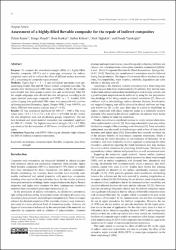Assessment of a highly-filled flowable composite for the repair of indirect composites
Citation
Kanar Ö, Meşeli S, Korkut B, Köken S, Tağtekin D, Yanıkoğlu F (2024). Assessment of a highly-filled flowable composite for the repair of indirect composites. Journal of Oral Science 66(1), 42-49.Abstract
Purpose: To compare the shear-bond-strength (SBS) of a highly-filled flowable composite (HFFC) and a paste-type composite for indirect
composite repair and to evaluate the effect of different surface treatments
(ST), concerning the composite repair protocol.
Methods: Eighty-four 5 × 5 × 2 mm cylindrical specimens were pre pared using Gradia Plus and SR Nexco indirect composite materials. The
samples were thermocycled 5,000 times. According to the ST, the samples
were divided into three groups (control, bur, and air-abrasion). After ST,
the sample subgroups were divided into two sub-groups according to the
repair material: paste-type composite and HFFC (n = 7). Another 5,000
cycles of aging were performed. SBS values were measured with a univer sal testing machine (Shimadzu, Japan). Shapiro-Wilk, 3-way ANOVA, and
Tukey HSD test were used to evaluate data (P < 0.05).
Results: ST was considered significant for SBS (P < 0.001). The mean
values were (13.9 ± 5.7), (17.0 ± 6.4), (20.4 ± 4.9) MPa for the control,
bur and phosphoric acid, and air-abrasion groups, respectively. The sur face treatment and repair material interaction was considered significant
for SBS (P = 0.044). The highest mean bond strength (24.5 ± 4.5 MPa)
was observed for the interaction of SR Nexco, air-abrasion ST, and HFFC
repair.
Conclusion: Repairing with HFFC following air abrasion might enhance
the SBS for indirect composite restorations.
Source
Journal of Oral ScienceVolume
66Issue
1URI
https://www.jstage.jst.go.jp/article/josnusd/66/1/66_23-0166/_articlehttps://doi.org/10.2334/josnusd.23-0166
https://hdl.handle.net/20.500.12780/767


















